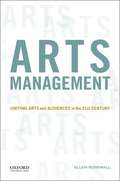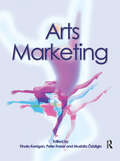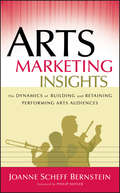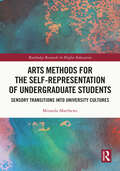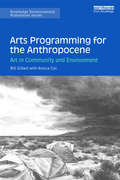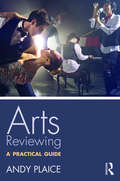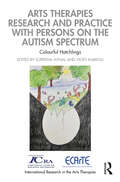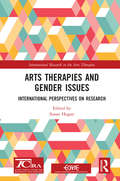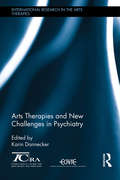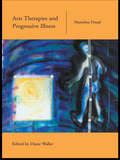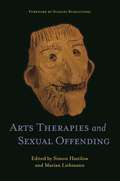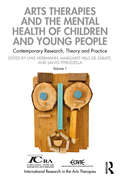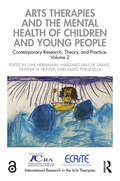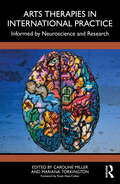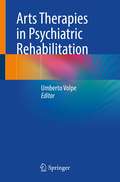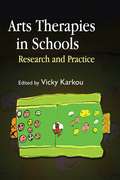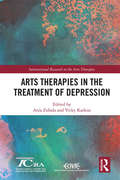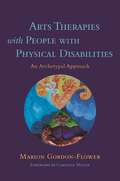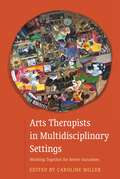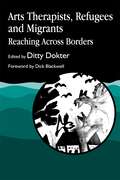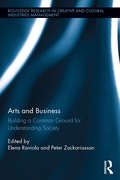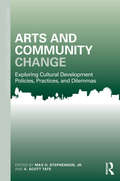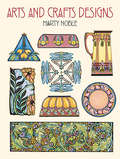- Table View
- List View
Arts Management: Uniting Arts And Audiences In The 21st Century
by Ellen RosewallDesigned for students and practitioners with little experience in not-for-profit management, Arts Management provides an indispensable guide to the theory and practice of managing arts and cultural organizations. This concise text engages readers with case studies and critical-thinking exercises that will develop their ability to adapt to a changing industry. From governance and human resources to program development, financial management, and marketing, Arts Management addresses the unique atmosphere of managing the arts today. It meets the standards of the AAAE (Association of Arts Administration Educators) guaranteeing that both current and future practitioners will be prepared to meet the challenges of managing today's arts organizations.
Arts Marketing
by Finola Kerrigan Peter Fraser Mustafa OzbilginArts Marketing focuses on a variety of sectors within the arts and addresses the way in which marketing principles are applied within these, outlining both the similarities and the differences that occur. Relating policy to practice, this contributed text demonstrates the most effective means of marketing in specific areas of the arts, with each chapter having been written by a specialist in the field. Although primarily focusing on the UK market, the subject has global relevance and appeal, and policy is evaluated on national, European and supranational levels. Specialist topics dealt with range from the marketing of the theatre, opera, and museums, through to the film industry and popular music.
Arts Marketing Insights
by Philip Kotler Joanne Scheff BernsteinAudience behavior began to shift dramatically in the mid 1990s. Since then, people have become more spontaneous in purchasing tickets and increasingly prefer selecting specific programs to attend rather than buying a subscription series. Arts attenders also expect more responsive customer service than ever before. Because of these and other factors, many audience development strategies that sustained nonprofit arts organizations in the past are no longer dependable and performing arts marketers face many new challenges in their efforts to build and retain their audiences. Arts organizations must learn how to be relevant to the changing lifestyles, needs, interests, and preferences of their current and potential audiences.Arts Marketing Insights offers managers, board members, professors, and students of arts management the ideas and information they need to market effectively and efficiently to customers today and into the future. In this book, Joanne Scheff Bernstein helps readers to understand performing arts audiences, conduct research, and provide excellent customer service. She demonstrates that arts organizations can benefit by expanding the meaning of "valuable customer" to include single-ticket buyers. She offers guidance on long-range marketing planning and helps readers understand how to leverage the Internet and e-mail as powerful marketing channels. Bernstein presents vivid case studies and examples that illustrate her strategic principles in action from organizations large and small in the United States, Great Britain, Australia, and other countries.
Arts Methods for the Self-Representation of Undergraduate Students: Sensory Transitions into University Cultures (Routledge Research in Higher Education)
by Miranda MatthewsThis timely book explores the transitional experiences of undergraduates in minority groups studying at university and how arts methods and practices can play an important role in facilitating these transitions. Based on research from UK universities, this volume is the first to draw together the experiences of educators in the humanities and social sciences who integrate sensory methodologies in taught curriculum, in relation to arts educators who add extra-curricular arts practice. It offers an original, contextualised analysis of how to enable university structures to adapt to complexity, difference, and diversity, taking the view that arts practice forms meeting points for confident interconnection and spaces of self-representation. It outlines the novel concept of sensory transition in how arts practices can be used to address issues of inclusion, diversity, and self-representation for minority groups. Each chapter offers an in-depth analysis of significant issues, such as dimensions of race, gender, and class and the specificities of social and cultural group experiences as they occur in arts practice. The book reflects on the decolonisation of university structures and curriculum and demonstrates how universities can support students and build spaces for self-representation in academic courses. Accessible and investigative, this book is essential reading for academics, researchers, and postgraduate students in the field of higher education, inclusion, and arts methods. It will also be of great interest to higher education staff interested in decolonisation, diversity, and university futures.
Arts Programming for the Anthropocene: Art in Community and Environment (Routledge Environmental Humanities)
by Bill Gilbert Anicca CoxArts Programming for the Anthropocene argues for a role for the arts as an engaged, professional practice in contemporary culture, charting the evolution of arts over the previous half century from a primarily solitary practice involved with its own internal dialogue to one actively seeking a larger discourse. The chapters investigate the origin and evolution of five academic field programs on three continents, mapping developments in field pedagogy in the arts over the past twenty years. Drawing upon the collective experience of artists and academicians in the United States, Australia, and Greece operating in a wide range of social and environmental contexts, it makes the case for the necessity of an update to ensure the real world relevance and applicability of tertiary arts education. Based on thirty years of experimentation in arts pedagogy, including the creation of the Land Arts of the American West (LAAW) program and Art and Ecology discipline at the University of New Mexico, this book is written for arts practitioners, aspiring artists, art educators, and those interested in how the arts can contribute to strengthening cultural resiliency in the face of rapid environmental change.
Arts Property and Hotel
by Arthur I SegelJulio Martinez finds himself as one of the owners of the Arts Hotel Project in Barcelona, Spain. The 455-room hotel is managed by the Ritz Carlton and is in a 44-story tower along Barcelona's beachfront. Julio needs to figure out a strategy to maximize his investment, including a negotiation of the Ritz's operating agreement. Includes color exhibits.
Arts Reviewing: A Practical Guide
by Andy PlaiceArts Reviewing: A Practical Guide is an accessible introduction to the world of arts criticism. Drawing on professional expertise and a range of cultural reviews from music, film, theatre, visual arts, television and books, Andy Plaice discusses different approaches to arts criticism, with tips on crafting great reviews. Chapters explore: • a brief history of arts criticism; • researching and preparing for an assignment; • legal and ethical boundaries when reviewing; • finding your own writing style; • starting and sustaining a career in arts criticism in the digital age. The book is underpinned by over 20 interviews with leading practitioners from across Britain, America and Australia. They offer fascinating insights into the life of a critic, including their best and worst career moments and the debates impacting the field of arts criticism. Interviewees include Neil McCormick, rock critic at the Daily Telegraph, the Guardian theatre critic Lyn Gardner and television critic Mark Lawson (BBC/ the Guardian). New approaches to reviewing techniques and writing style are combined with real-world advice from leading professionals in the field, making this book an ideal resource for students and graduates of journalism, cultural studies and media studies.
Arts Therapies Research and Practice with Persons on the Autism Spectrum: Colourful Hatchlings (International Research in the Arts Therapies)
by Vicky Karkou Supritha AithalThis volume presents cutting-edge research and practice on Creative Arts Therapies or Arts Therapies for individuals on the autism spectrum of all ages, outlining the development of effective and accessible approaches to support the diverse needs of this client group. Consisting of 14 research-based chapters with contributions from over 30 authors from across the world, the book brings together research from art, music, drama, dance, movement and other forms of art therapies. The book demonstrates how arts therapies have evolved over the years to address the health and social care needs of people on the autism spectrum and their caregivers. Chapters explore the implications of arts therapies across a spectrum of needs in various settings and offer a comprehensive picture including a variety of research outcomes and therapeutic processes, and critiques both of existing practice and research methodologies. The book will be key reading for researchers, scholars and clinicians from dance movement therapy, music therapy, art therapy, dramatherapy and expressive arts therapies. It will also be of interest to post-graduate students and mental health professionals working with children, adults and families of individuals on the autism spectrum.
Arts Therapies and Gender Issues: International Perspectives on Research (International Research in the Arts Therapies)
by Susan HoganArts Therapies and Gender Issues offers international perspectives on gender in arts therapies research and demonstrates understandings of gender and arts therapies in a variety of global contexts. Analysing current innovations and approaches in the arts therapies, it discusses issues of cultural identity, which intersect with sex, gender norms, stereotypes and sexual identity. The book includes unique and detailed case studies such as the emerging discipline of creative writing for therapeutic purposes, re-enactment phototherapy, performative practice and virtual reality. Bringing together leading researchers, it demonstrates clinical applications and shares ideas about best practice. Incorporating art, drama, dance and music therapy, this book will be of great interest to academics and researchers in the fields of arts therapies, psychology, medicine, psychotherapy, health and education. It will also appeal to practitioners and teachers of art, dance-movement, drama and music therapy.
Arts Therapies and New Challenges in Psychiatry: New Challenges in Psychiatry (International Research in the Arts Therapies)
by Karin DanneckerDespite their increasing popularity and reported effectiveness, there is a dearth of evidence-based research on the practices that fall under the umbrella of "the arts therapies". The successful treatment of a variety of psychiatric illnesses through the application of the arts therapies has long been recognized in many countries around the world, including psychosis, schizophrenia, depression and borderline symptoms. Providing valuable data on the effectiveness of the arts therapies, Arts Therapies and New Challenges in Psychiatry fills an important gap in the literature on psychiatric illnesses. Contributors to this impressive volume have carried out research in psychiatry and mental health with patients diagnosed with a variety of illnesses. The international focus of the book shows the global, cross-cultural relevance of the arts therapies, whilst quantitative and qualitative evidence is used to demonstrate the need for art-, music-, drama- and dance therapy in a wide variety of contexts. This book shows that research in these fields can be carried out convincingly using a broad range of approaches, including each field's own professional matrix. Providing a much-needed assessment of the arts therapies, this book will appeal to art therapists, music therapists, dance therapists and drama therapists, as well as psychiatrists, psychologists, psychoanalysts and educators of arts therapy training.
Arts Therapies and Progressive Illness: Nameless Dread
by Diane WallerArts Therapies and Progressive Illness is a guide to the use of arts therapies in the treatment of patients with diseases such as Parkinson's and Alzheimer's. In the last few years arts therapies have been used in an increasingly wide range of applications with new groups of patients, such as patients in palliative care, or with learning disabilities - Diane Waller has been a driving force behind this expansion.This book covers treatment such as art therapy, dance movement therapy and music therapy. In addition to dealing with a wide range of debilitating diseases, it focuses on the issue of the care and treatment of dementia and the effects on patients, carers and staff and the role of the arts therapies in improving the quality of life for the increasing number of patients who will sadly develop this distressing illness.This broadly focused, multi-disciplinary book will be of great interest to arts therapists, arts therapy educators, medical, social work and other staff who are concerned to devise care plans for these patients and their relatives.
Arts Therapies and Sexual Offending
by Anna Green Katie Smith Themis Kyriakidou Jessica Collier Emma Allen Ronald Lay Preetha Ramasubramanian Dawn Batcup Kate Burn Rosy Marshall Eva Marie Chadwick Amy Pfenning Marian Husted Maxine Daniels Lucy Gibson-Hill Alice Myles Katie Greenwood Kate Snowden Thijs De Moor Steve CobbettA resource for arts therapists and other clinicians on working with people who have committed sexual offences.There is a strong focus on the value of establishing a therapeutic relationship involving non-verbal media as a cornerstone, drawing upon current research and practice. Emphasis is placed on working with transference and counter-transference, being trauma-informed, and making use of effective supervision.This group of offenders can benefit hugely from the provision of arts therapies, and this book provides valuable experiences of working with people who have committed sexual offences.
Arts Therapies and the Mental Health of Children and Young People: Contemporary Research, Theory and Practice, Volume 1 (International Research in the Arts Therapies)
by Uwe HerrmannArts Therapies and The Mental Health of Children and Young People presents innovative research, theory and practice in the arts therapies. The different social, cultural and political contexts and developmental age groups illustrate and underscore the richness and diversity of contemporary arts therapies' creative response to the needs of children and young people in contrasting locations. The book represents an acknowledgement of the high rates of mental disorders in children and young people and addresses this subject. In presenting an array of responses from arts therapists working with children and young people in different contexts and countries, the book highlights the particular features of distinct art forms, yet also points to the potential dialogue between disciplines. Chapters show how the expressive potential and appeal of the arts, when facilitated within the therapeutic relationship, are crucial in fostering hope in the future and the capacity for trust in self and others. This book will be of great interest to arts therapists as well as academics and postgraduate students in the fields of arts therapies, social work, psychotherapy, health psychology, and education.
Arts Therapies and the Mental Health of Children and Young People: Contemporary Research, Theory, and Practice, Volume 2 (ISSN)
by Salvo Pitruzzella Uwe Herrmann de Zárate, Margaret Hills Heather M. HunterThis second volume expands and develops the discussion on arts therapies begun in volume one on the field’s relationship with children and young people’s mental health, demonstrating further contemporary research within international contexts.The book responds to a resounding call to address children and young people’s mental health. It explores a unique mix of diverse arts modalities including art, music, dance, expressive arts, and drama, creating opportunities for discourse and discussion of how the different arts therapies cohere and relate to each other. Chapters are truly global in approach, ranging from schools in India to children’s hospices in the United Kingdom, refugee transit camps in Greece, and residential care programmes for LGBTQ+ youth in the United States. Discussions from Greece and Taiwan, and innovative research from Israel, Norway, and Scotland are also featured with reference to diverse social, political, and cultural contexts. Ultimately, chapters prioritise the links between research, theory, and practice, providing accessible and implication-led dialogue on contemporary issues.This book provides new insights into the expanding field of the arts therapies and will be of great interest to arts therapists as well as academics and students in the fields of arts therapies, social work, psychotherapy, health psychology, and education.
Arts Therapies in International Practice: Informed by Neuroscience and Research
by Caroline Miller Mariana TorkingtonArts Therapies in International Practice: Informed by Neuroscience and Research brings together practice and research in the arts therapies and in neuroscience. The authors are all arts therapists who have reviewed their practice through the lens of modern neuroscience. Neuroscience confirms the importance of embodiment, choice, and creativity in therapy with a range of clients. Arts therapies directly provide these. The authors demonstrate how the arts therapies can be adapted creatively to work in different social and ethnic communities, with different ages and with different states of health or ill health. Although there is diversity in their practice and country of practice, they reaffirm key concepts of the arts therapies, such as the importance of the therapeutic relationship, and the key role played by the arts modality with its effects on the brain and nervous system. This book will appeal to a wide readership, including arts therapists, expressive arts therapists, a range of other psychotherapists and counsellors, students and their teachers, and those interested in the neuroscience of human development.
Arts Therapies in Psychiatric Rehabilitation
by Umberto VolpeThis book explores possible approaches to and uses of art therapy in mental health settings. Reflecting the latest scientific evidence, it represents a major step toward the harmonization of practices in the field, filling the gap between the theory and practice of art therapy. The book is divided into four major sections, corresponding to the main artistic domains: visual art therapy, music therapy, dance movement therapy, and drama therapy. Gathering the research and insights of leading professionals from around the globe, the book offers a diverse and balanced mix of perspectives. Accordingly, it will appeal to a broad readership including psychiatrists, psychologists, social workers, occupational therapists, psychiatric rehabilitation technicians, nurses, educators, art therapists, and students.
Arts Therapies in Schools
by Edited by Vicky KarkouAs arts therapists are increasingly working in schools, there is growing interest in identifying applicable therapeutic approaches and expanding on relevant research evidence. This book outlines the potential uses of music, art, drama and dance movement therapies in educational settings, and the contribution they have to make to the emotional and social development of children and adolescents. Drawing on international evidence, the book outlines a wide range of innovative applications of arts therapies across a range of settings, including mainstream classrooms, special schools and student support units. Examples of subjects covered include solution-focused brief dramatherapy groupwork in mainstream education, art therapy for children with specific learning difficulties who have experienced trauma and music therapy in special education. Particular emphasis is placed upon collaborative work, whether it be between arts therapists from different disciplines, arts therapists and teaching staff or arts therapists and researchers. Arts Therapies in Schools will be of great interest to arts therapists, and will also be useful to others who want to know about the potential of arts therapies in the classroom, including teachers and other education professionals, health professionals, educational psychologists, school counsellors and policy makers.
Arts Therapies in the Treatment of Depression (International Research in the Arts Therapies)
by Vicky Karkou Ania ZubalaArts Therapies in the Treatment of Depression is a comprehensive compilation of expert knowledge on arts therapies’ potential in successfully addressing depression. The book identifies ways of addressing the condition in therapy sessions, shares experience of tools and approaches which seem to work best and guides towards a conscious and confident evidence-based practice. Including contributions from international experts in the field of arts therapies, the book presents some of the most recent, high-profile and methodologically diverse research, whether in the form of clinical trials, surveys or case studies. The three sections of this volume correspond to particular life stages and explore major topics in arts therapies practice and the nature of depression in children, adults and in later life. Individual chapters within the three sections represent all four arts therapies disciplines. The book hopes to improve existing arts therapies practice and research, by encouraging researchers to use creativity in designing meaningful research projects and empowering practitioners to use evidence creatively for the benefit of their clients and the discipline. Arts Therapies in the Treatment of Depression is an essential resource for arts therapies researchers, practitioners and arts therapists in training. It should also be of interest to other health researchers and health professionals, particularly those who work with clients experiencing depression and in multidisciplinary teams.
Arts Therapies with People with Physical Disabilities: An Archetypal Approach
by Marion Gordon-FlowerFor those with mobility and communication challenges, arts therapies can be especially significant and rewarding as a means of self-expression and engaging with others. This book provides practical guidance on multimodal and archetypal arts therapy approaches adapted specifically for a physical disability context. Practical strategies and interventions are given, alongside case studies from individual and group arts therapy sessions. The author acknowledges the challenges of working with clients with physical disabilities, such as physical assistance in using resources, subtleties in communication of preferences and the need for extra members of staff, and gives clear guidance for accessible and effective sessions. This is essential reading for any arts therapist wanting a tailored approach to meeting the needs of people with physical disabilities, with a focus on person-centred and strengths-based methods. In addition, all frameworks covered are also adaptable for other client groups.
Arts Therapists in Multidisciplinary Settings: Working Together for Better Outcomes
by Caroline Miller Steve Harvey Mariana Torkington Robin Barnaby Abigail Raymond Marion Gordon-Flower Alison Talmage Tosca Lammerts Van Bueren Heather Fletcher Lucy-Mary Mulholland Agnès Desombiaux-Sigley Adrian Zygmu Lania Keryn Squires Jennie Halliday Judy Donovan Shari Storie Neetu Sharma Anaia Treefoot Megan SpraggIn a multidisciplinary setting or team, competing perspectives and principles can be challenging to negotiate, but supportive working relationships and effective collaboration can ultimately lead to an enriched experience and innovative outcomes for both professionals and clients. Drawing on their diverse experiences, art, music, drama, play and dance therapists emphasise the valuable results that their respective disciplines can produce when applied in settings ranging from schools to hospices, in collaboration with behaviour therapists, teachers, occupational therapists, speech therapists and other practitioners. The book provides a unique perspective on the common issues faced by arts therapists when working with other professionals and will assist arts therapists in promoting their profession to co-workers and clients.
Arts Therapists, Refugees and Migrants: Reaching Across Borders
by Ditty DokterThe legal and humanitarian response to the world's growing population of refugees and migrants has created more awareness of not only the physical but also the psychological needs of displaced peoples. Refugees are often the forgotten victims of war violence and political upheaval, subjected to the traumatic loss of family and home and the consequent deterioration of cultural identity as they seek asylum in other countries. Ditty Dokter is joined by contributors from a number of multicultural backgrounds, in a volume examining the issues surrounding intercultural arts therapies as a means of working with clients who are refugees and migrants. The role of art, music, dance, and drama in healing the effects of trauma and restoring the sense of cultural and personal identity is discussed, emphasising the need for sensitivity to cultural differences in practice. The ultimate aim is to promote more awareness of intercultural issues in an attempt to build a broader framework for arts therapy practice.
Arts and Aesthetics in a Globalizing World (Association Of Social Anthropologists Monographs)
by Raminder Kaur Parul Dave-MukherjiThis is an investigation of arts and aesthetics in their widest senses and experiences, presenting a variety of perspectives which range from the metaphysical to the political. Moving beyond art as an expression of the inner mind and invention of the individual self, the volume bridges the gap between changing perceptions of contemporary art and aesthetics, and maps globalizing currents in a number of contexts and regions.The volume includes an impressive variety of case studies offered by established leaders in the field and original and emerging scholarly talent covering areas in India, Nepal, Indonesia, Iran, Russia, Rwanda, and Germany, as well as providing transnational or diasporic perspectives. From the contradictory demands made on successful artists from the south in the global art world such as Anish Kapoor, to images of war and puppetry created by female political prisoners, the volume compels creative and political interpretations of the ever-changing and globalizing terrain of arts and aesthetics.
Arts and Business: Building a Common Ground for Understanding Society (Routledge Research in the Creative and Cultural Industries #6)
by Peter Zackariasson Elena RaviolaArts and Business aims at bringing arts and business scholars together in a dialogue about a number of key topics that today form different understandings in the two disciplines. Arts and business are, many times, positioned as opposites. Where one is providing symbolic and aesthetic immersion, the other is creating goods for a market and markets for a good. They often deal and struggle with the same issues, framing it differently and finding different solutions. This book has the potential of offering both critical theoretical and empirical understanding of these subjects and guiding further exploration and research into this field. Although this dichotomy has a well-documented existence, it is reconstructed through the writing-out of business in art and vice versa. This edited volume distinguishes itself from other writings aimed at closing the gap between art and business, as it does not have a firm standpoint in one of these fields, but treating them as symmetrical and equal. The belief that by giving art and business an equal weight, the editors also create the opportunity to communicate to a wider audience and construct a path forward for art and business to coexist.
Arts and Community Change: Exploring Cultural Development Policies, Practices and Dilemmas (Community Development Research and Practice Series)
by Max O. Stephenson Jr. Scott TateArts and Community Change: Exploring Cultural Development Policies, Practices and Dilemmas addresses the growing number of communities adopting arts and culture-based development methods to influence social change. Providing community workers and planners with strategies to develop arts policy that enriches communities and their residents, this collection critically examines the central tensions and complexities in arts policy, paying attention to issues of gentrification and stratification. Including a variety of case studies from across the United States and Canada, these success stories and best practice approaches across many media present strategies to design appropriate policy for unique populations. Edited by Max Stephenson, Jr. and A. Scott Tate of Virginia Tech, Arts and Community Change presents 10 chapters from artistic and community leaders; essential reading for students and practitioners in economic development and arts management.
Arts and Crafts Designs (Dover Pictorial Archive)
by Marty NobleInspirational, practical source of 125 superb, royalty-free illustrations for use by graphic artists and designers. Masterfully adapted from textiles, wallpaper, and other authentic sources, the motifs depict florals and insects etched into glassware, garlands of flowers in square and circular configurations, dragonflies adorning decorative bowls and platters, and much more.
